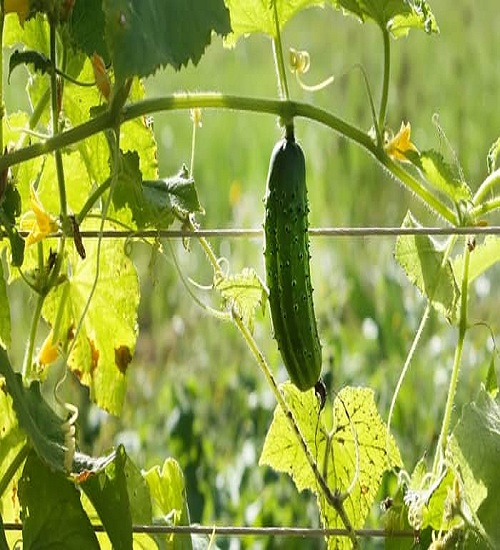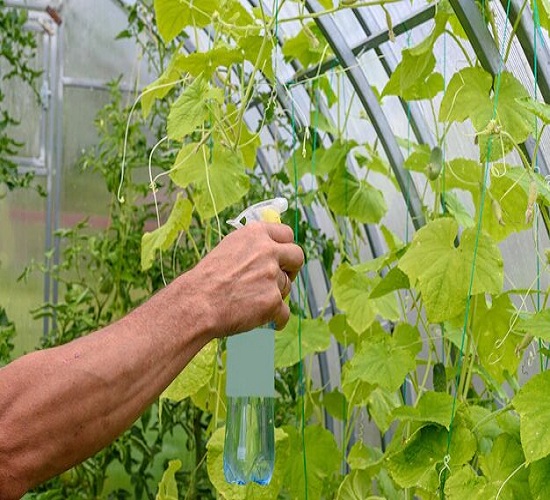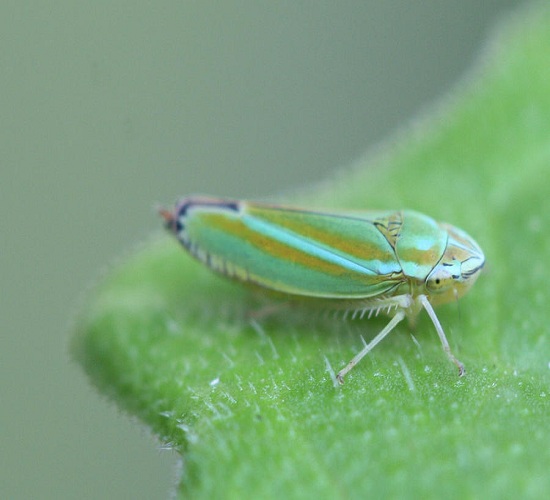When growing cucumbers, one of the most frequently asked questions is, “Why are my cucumber leaves going white?”
The whitened leaves of cucumber plants can be a serious hindrance. In this piece, we’ll try to discover what causes cucumber leaves to turn yellow.
Why Do My Cucumber Seedlings Have White Spots After Transplanting:
After transplanting, cucumber leaves that become white are experiencing transplant shock. When plants are moved from one site to another, they experience a time of stress due to a loss of water and nutrients, as well as changes in temperature or other environmental variables.
Why Are the Edges of My Cucumber Leaves Turning White?

It is possible for cucumber leaves to go white for a variety of causes. It could be the result of a disease, pest infestation, excessive wetness, unintentional blanching, or even simple maturation.
Let’s take a deeper look at these possible reasons:
1. Diseases
Powdery mildew is a common disease that can cause the cucumber leaves to turn yellow.

Powdery mildew disease:
You may see white powdery mildew covering your cucumber plant’s leaves, stems, and fruit. This fungus is brought on by a lack of airflow or sunlight in the plant’s surroundings. Starting with older leaves, the disease can spread to younger ones.
Cucumbers, zucchini, pumpkins, and other members of the Cucurbitaceae family are all susceptible to this disease.
Cucumber disease appears as a white or grey powder on the leaves and stems. An infection normally starts on the lower leaves and works its way up.
In extreme circumstances, it can completely cover the leaf. The spots begin as little, greyish-white patches that grow in size and join together to form larger colonies.
It can lead to stunted growth and twisted, deformed leaves if left untreated. The plant will wither and perish in the end.
When dealing with powdery mildew, you need to take all the required precautions to keep it out of your garden.
Because they are spread by wind, the spores can swiftly infect plants. Since this disease often attacks behind the leaves and goes undetected until it is too late, it is easy to see why it is so difficult to combat.

How to Treat Powdery Mildew Disease:
It is not hazardous to the plant, but the white spots that appear on its leaves do decrease its capacity to photosynthesize.
As a result, your plant will receive less sunlight, limiting its ability to thrive. As long as this disease isn’t dealt with, it might leave plants more vulnerable to other diseases and possibly death.
Prevention and early detection of powdery mildew are the most effective ways to combat the disease.
To begin, make sure your cucumber plants are receiving at least six hours of direct sunlight each day.
To prevent the transmission of spores, clean up the cucumber patch of any dead plants or trash.
Cucumbers are susceptible to powdery mildew, which can be prevented with a homemade fungicide. Using a tablespoon of baking soda and a tablespoon of dish soap, mix 1 gallon of water and 1 gallon of water together.
If your tap water contains chlorine or salts, which might harm your plants, use distilled water. To ensure a uniform distribution of baking soda in the water, shake the mixture vigorously.
In warm weather, when the temperature rises above 75 degrees Fahrenheit, this combination should be sprayed on the cucumber leaves monthly.
Apply a generous amount of solution to the leaves of your plant, being careful not to get any on the fruit.
Cucumber plants can also be sprayed with a 1 tablespoon baking soda/1 gallon water solution.
Vinegar can also be used to treat fungus. A solution of 3 Tbsp vinegar to 1-gallon water sprayed on the leaves works wonders. Vinegar might burn the leaves if you add too much to the solution.
2. Pests
Whitening cucumber leaves may also be caused by an insect infestation. Leafhoppers, for example, are a type of arachnid.
The leafhopper: Empoasca spp

When a leafhopper is disturbed, it will jump out of the way of its prey. This distinguishes it from other insects. Stem and leaf juice is extracted by sucking on them. Leaves turn yellow and begin to curl up.
You can use a variety of organic pest control methods to keep your cucumber plant safe.
In the case of severe infestations, a spray produced from garlic extract and water could be helpful.
3. Excessive Moisture

Cucumbers prefer soil that is both moist and well-drained. When the soil is always moist, the plant’s roots are unable to receive nutrients from the soil, resulting in leaf discolouration.
Moisture buildup on leaves is a regular issue. If water droplets are allowed to rest on leaves for an extended period of time, they will turn the leaves white. Moisture on the leaves of plants can potentially encourage the growth of the disease.
4. Poor Cultural Control
White patches might be caused by a lack of room or a lack of effective cultural control.
White spots may form on the leaves of cucumbers if they are not properly cared for.
Soil with a pH between 6 and 7 is ideal for them. Garden in full sun, but give them afternoon shade if you live in a place that is hotter.
Make sure you plant them at least a week after the last frost date. Each plant should be at least a foot apart so that its roots have room to grow.
The soil around each plant should be watered on a regular basis to prevent fungus problems.
5. Accidental Blanching
Accidental blanching is one of the most prevalent causes of cucumber leaves turning white. Cucumbers can be accidentally blanched if heavy foliage is placed on top of them.
Cucumbers can be blanched in the garden by burying them in straw or otherwise preventing sunlight from reaching the fruit.
The only problem with this method is that it can mistakenly blanch your plants if you cover them with a thick layer of mulch or straw. White, pale leaves may result if the roots are deprived of adequate oxygen.
Cucumber leaves that have been accidentally blanched will have less chlorophyll and will have a white or yellowish hue, which is undesirable.
6. The Process of Natural Aging
As cucumber plants mature and begin producing seeds, they naturally turn white. As soon as they start developing seed pods, they divert nutrients from fruit production and use them to grow seeds.
Leaves will turn a pale yellow or white tint as a result of this.
Conclusion:
White spots on cucumber leaves can occur for a variety of causes. The plant’s survival depends on finding out what is causing the problem.
After reading this essay, I’m confident you’ll be able to pinpoint the issue and take the necessary steps to resolve it.
Cucumber plants can be kept healthy and free of disease by following these simple guidelines.

